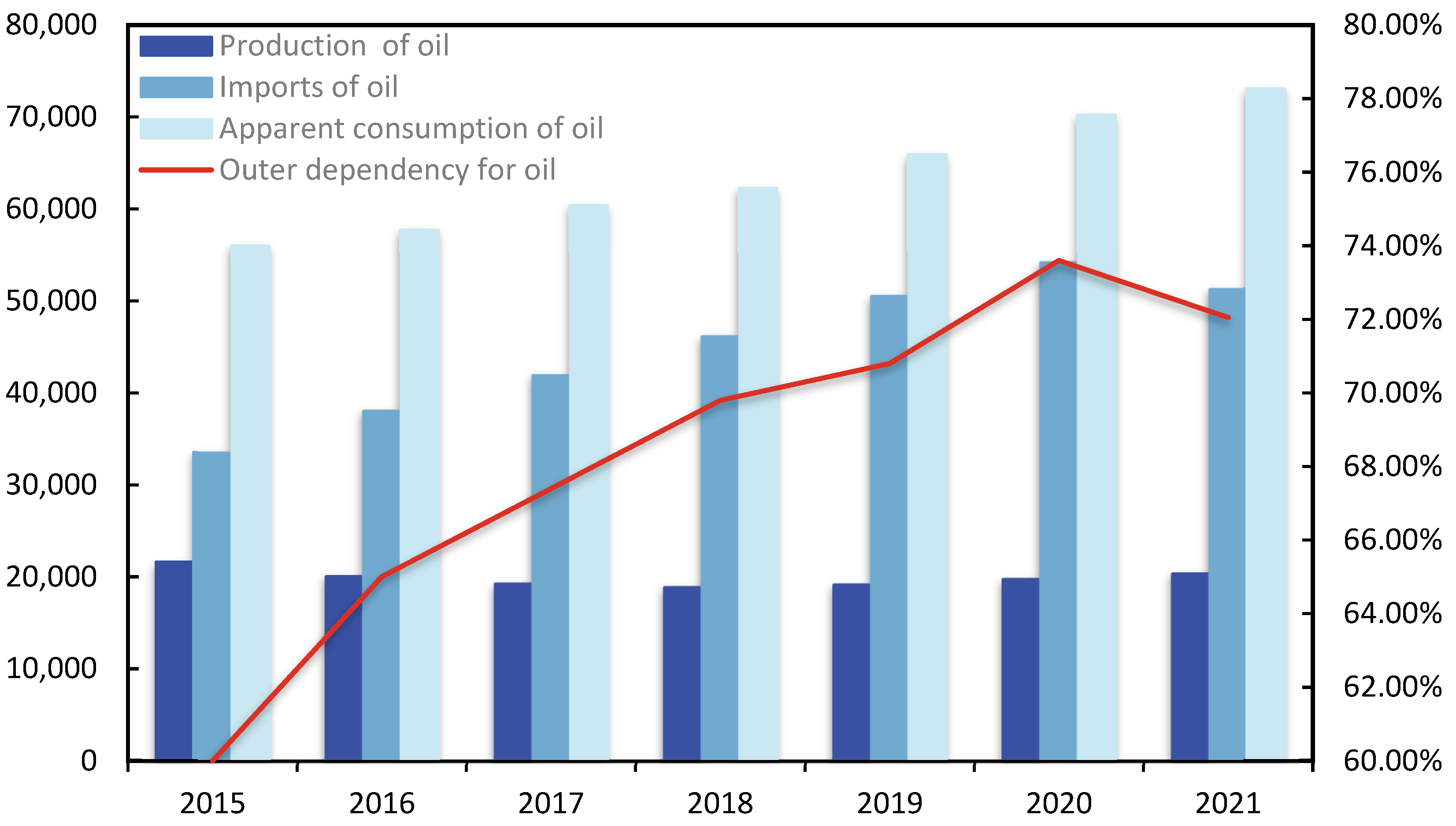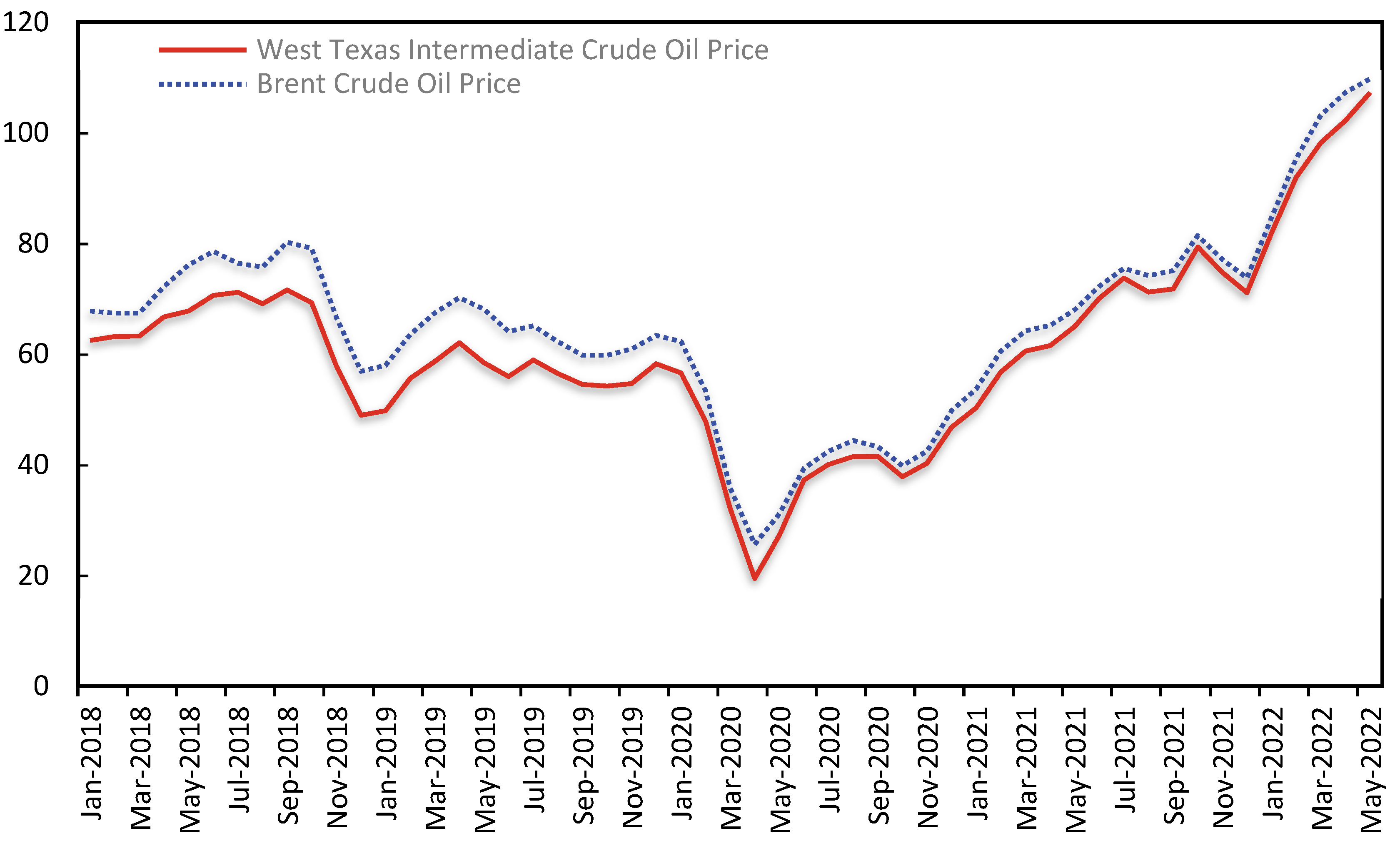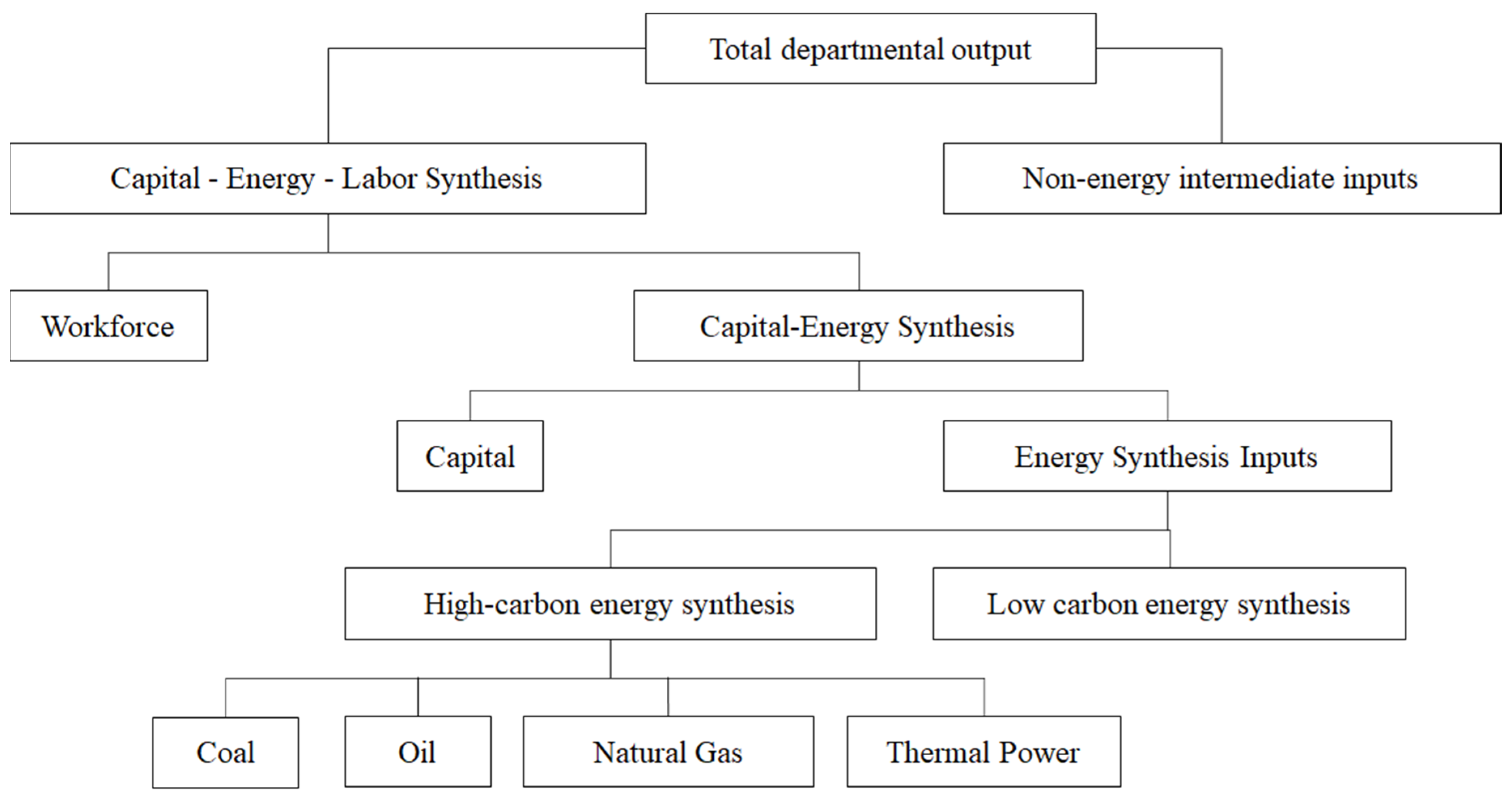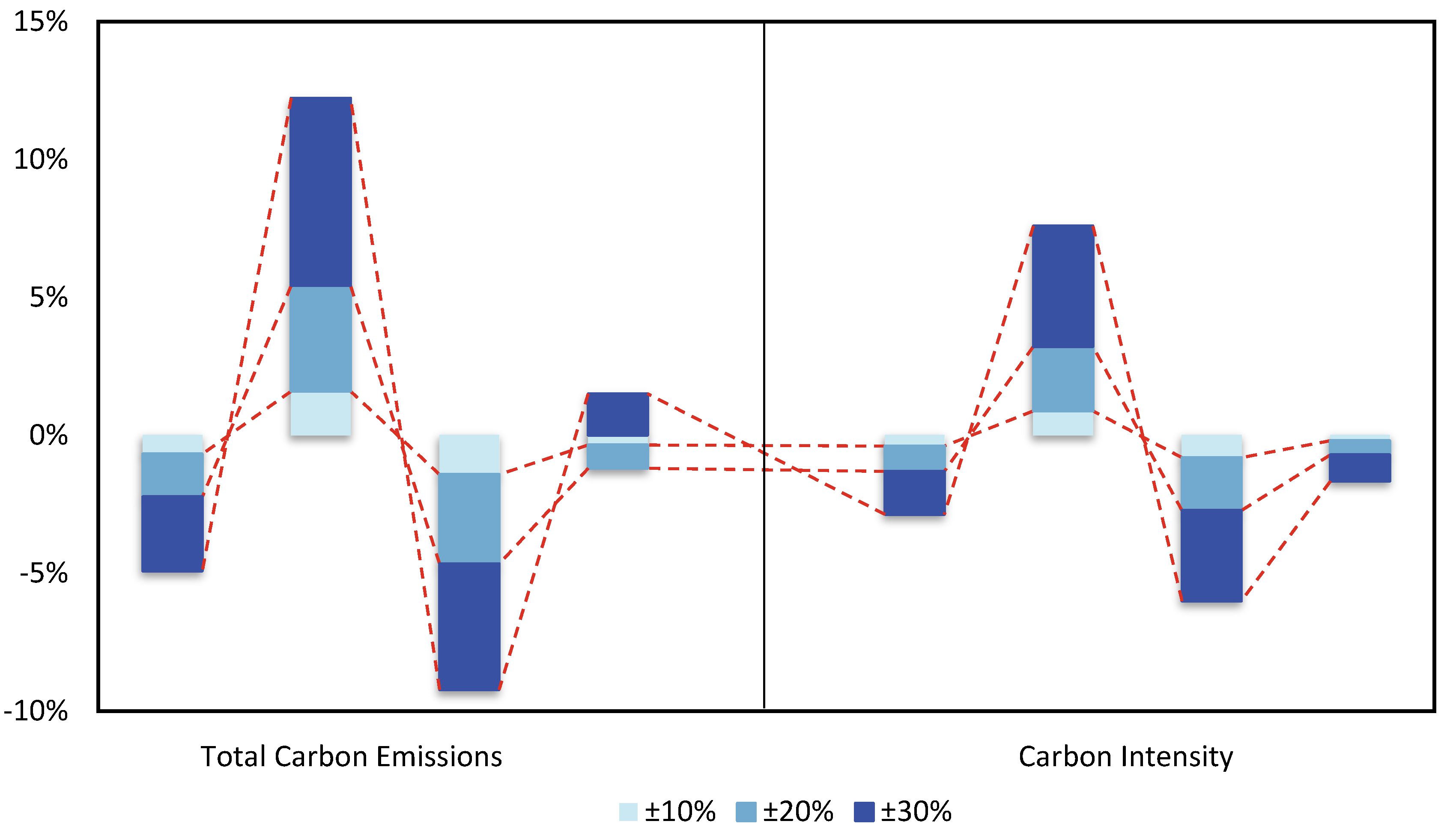Synergistic Effects of International Oil Price Fluctuations and Carbon Tax Policies on the Energy–Economy–Environment System in China
Abstract
1. Introduction
2. Literature Review
3. Model Construction and Data Description
3.1. CGE Model
3.2. Data Description
4. Scenario Formulation and Simulation Evaluation
4.1. Scenario Formulation
4.2. Impact Analysis of Scenario Combination on Energy
4.3. Impact Analysis of Scenario Combination on Economy
4.4. Impact Analysis of Scenario Combination on Environment
5. Conclusions and Policy Recommendations
5.1. Conclusions
- (1)
- China’s energy imports are substantial and international energy prices are dominated by oil prices. Therefore, an increase in international oil prices leads to an increase in domestic fossil energy prices, which reduces the demand for fossil energy and increases the demand for clean power, resulting in a reduction in overall energy consumption. In contrast, dropping international oil prices have the opposite effect.
- (2)
- A rise in international oil prices increases production costs for firms and produces inflation, resulting in a decrease in local output and investment. A significant decline in international oil prices, on the other hand, results in deflation, which has a negative impact on domestic output and investment. A rise in international oil prices is damaging to labor-intensive businesses, such as light industry and agriculture, whereas a decline in international oil prices will enhance output in industries other than construction.
- (3)
- An increase in international oil prices can mitigate the environmental pollution caused by carbon emissions to some extent, whereas a decrease in international oil prices will result in an increase in the total and intensity of China’s carbon emissions, which is not conducive to China achieving its carbon peak and carbon neutral goals. The influence of international oil price fluctuations in both directions on carbon emissions is not symmetrical.
- (4)
- The carbon tax has a significant impact on reducing fossil energy demand and carbon emissions as well as promoting the demand for clean electricity, and the linkage mechanism between carbon tax and international oil price fluctuations is conducive to enhancing energy saving and emission reduction effects. In other words, when the international price of oil declines dramatically, the carbon tax rate should be increased proportionally, and vice versa.
5.2. Policy Recommendations
- (1)
- Encourage the optimization and modernization of energy structure to lessen reliance on oil imports. Reduce the share of high-carbon energy consumption in the energy structure by supporting the optimization and upgrading of the energy structure. Alternately, the market and policy instruments can direct the formation of a reasonable pattern of energy usage.
- (2)
- Implement a multi-directional and multi-channel pattern of oil delivery in order to mitigate the risk of abrupt shifts in international relations and frequent regional conflicts. Additionally, pay particular attention to the trend of oil price fluctuations. When international oil prices decline, it is vital to sustain the rate of oil exploration and development in order to enhance the domestic oil supply capacity and increase oil imports in order to increase strategic oil reserves. When oil prices are high, it is important to sell at the proper time in order to lower the cost of oil imports, boost the pricing power of international oil prices, and mitigate the impact of growing international oil prices on the domestic economy.
- (3)
- When creating legislation about climate change, it is important to consider the rippling impact of oil prices. Continue to reinvent the system of carbon tax regulation and perform a complementary function to carbon emissions trading. In addition to limiting fossil fuel usage, the carbon tax should attempt to increase the efficiency of fossil fuel utilization. The government should assist manufacturers who optimize oil use patterns and create fossil energy technologies in order to further optimize the energy structure, reduce energy intensity, and speed up the greening of the economy.
- (4)
- Against the backdrop of persistently low international oil prices, the government is compelled to employ policy instruments, particularly environmental levies or more direct carbon tax policies. By increasing the price of fossil fuels to lessen the environmental effect caused by their increased consumption, the transition to a low-carbon energy system is facilitated.
Author Contributions
Funding
Institutional Review Board Statement
Informed Consent Statement
Data Availability Statement
Conflicts of Interest
References
- Wang, K.-H.; Su, C.-W.; Umar, M. Geopolitical Risk and Crude Oil Security: A Chinese Perspective. Energy 2020, 219, 119555. [Google Scholar] [CrossRef]
- Yang, H.; Li, P.; Li, H. An Oil Imports Dependence Forecasting System Based on Fuzzy Time Series and Multi-Objective Optmization Algorithm: Case for China. Knowl. Based Syst. 2022, 246, 108687. [Google Scholar] [CrossRef]
- Baumeister, C.; Kilian, L. Forty Years of Oil Price Fluctuations: Why the Price of Oil May Still Surprise Us. J. Econ. Perspect. 2016, 30, 139–160. [Google Scholar] [CrossRef]
- Pan, L.; Liu, P.; Li, Z. A System Dynamic Analysis of China’s Oil Supply Chain: Over-Capacity and Energy Security Issues. Appl. Energy 2017, 188, 508–520. [Google Scholar] [CrossRef]
- Xu, C.; Kohler, T.A.; Lenton, T.M.; Svenning, J.-C.; Scheffer, M. Future of the Human Climate Niche. Proc. Natl. Acad. Sci. USA 2020, 117, 11350–11355. [Google Scholar] [CrossRef] [PubMed]
- Mallapaty, S. How China Could Be Carbon Neutral by Mid-Century. Nature 2020, 586, 482–483. [Google Scholar] [CrossRef]
- Zhang, S.; Chen, W. Assessing the Energy Transition in China Towards Carbon Neutrality with a Probabilistic Framework. Nat. Commun. 2022, 13, 1–15. [Google Scholar] [CrossRef]
- Xu, G.; Schwarz, P.; Yang, H. Adjusting Energy Consumption Structure to Achieve China’s CO2 Emissions Peak. Renew. Sustain. Energy Rev. 2020, 122, 109737. [Google Scholar] [CrossRef]
- Bartram, S.M.; Hou, K.; Kim, S. Real Effects of Climate Policy: Financial Constraints and Spillovers. J. Financ. Econ. 2021, 143, 668–696. [Google Scholar] [CrossRef]
- Doğan, B.; Chu, L.K.; Ghosh, S.; Truong, H.H.D.; Balsalobre-Lorente, D. How Environmental Taxes and Carbon Emissions Are Related in the G7 Economies? Renew. Energy 2022, 187, 645–656. [Google Scholar] [CrossRef]
- Zakeri, A.; Dehghanian, F.; Fahimnia, B.; Sarkis, J. Carbon Pricing versus Emissions Trading: A Supply Chain Planning Perspective. Int. J. Prod. Econ. 2014, 164, 197–205. [Google Scholar] [CrossRef]
- Lin, B.; Jia, Z. What Will China’s Carbon Emission Trading Market Affect with Only Electricity Sector Involvement? A CGE Based Study. Energy Econ. 2018, 78, 301–311. [Google Scholar] [CrossRef]
- Liu, Y.; Lu, Y. The Economic Impact of Different Carbon Tax Revenue Recycling Schemes in China: A Model-based Scenario Analysis. Appl. Energy 2015, 141, 96–105. [Google Scholar] [CrossRef]
- Ma, Q.; Murshed, M.; Khan, Z. The Nexuses between Energy Investments, Technological Innovations, Emission Taxes, and Carbon Emissions in China. Energy Policy 2021, 155, 112345. [Google Scholar] [CrossRef]
- Jia, Z.; Wen, S.; Lin, B. The Effects and Reacts of COVID-19 Pandemic and International Oil Price on Energy, Economy, and Environment in China. Appl. Energy 2021, 302, 117612. [Google Scholar] [CrossRef]
- Gabriel, V.d.S.; Miralles-Quirós, M.; Miralles-Quirós, J. Shades between Black and Green Investment: Balance or Imbalance? Sustainability 2021, 13, 5024. [Google Scholar] [CrossRef]
- Brini, R.; Amara, M.; Jemmali, H. Renewable Energy Consumption, International Trade, Oil Price and Economic Growth Inter-linkages: The Case of Tunisia. Renew. Sustain. Energy Rev. 2017, 76, 620–627. [Google Scholar] [CrossRef]
- Wang, Q.; Li, S.; Pisarenko, Z. Heterogeneous Effects of Energy Efficiency, Oil Price, Environmental Pressure, R&D Investment, and Policy on Renewable Energy—Evidence from the G20 Countries. Energy 2020, 209, 118322. [Google Scholar] [CrossRef]
- Thorbecke, W. How Oil Prices Affect East and Southeast Asian Economies: Evidence from Financial Markets and Implications for Energy Security. Energy Policy 2019, 128, 628–638. [Google Scholar] [CrossRef]
- Mensah, I.A.; Sun, M.; Gao, C.; Omari-Sasu, A.Y.; Zhu, D.; Ampimah, B.C.; Quarcoo, A. Analysis on the Nexus of Economic Growth, Fossil Fuel Energy Consumption, CO2 Emissions and Oil Price in Africa Based on a PMG Panel ARDL Approach. J. Clean. Prod. 2019, 228, 161–174. [Google Scholar] [CrossRef]
- Mccollum, D.L.; Jewell, J.; Krey, V.; Bazilian, M.; Fay, M.; Riahi, K. Quantifying Uncertainties Influencing the Long-Term Impacts of Oil Prices on Energy Markets and Carbon Emissions. Nat. Energy 2016, 1, 16077. [Google Scholar] [CrossRef]
- Du, L.; Yanan, H.; Wei, C. The Relationship between Oil Price Shocks and China’s Macro-economy: An Empirical Analysis. Energy Policy 2010, 38, 4142–4151. [Google Scholar] [CrossRef]
- van Eyden, R.; Difeto, M.; Gupta, R.; Wohar, M.E. Oil Price Volatility and Economic Growth: Evidence from Advanced Economies Using More than a Century’s Data. Appl. Energy 2018, 233–234, 612–621. [Google Scholar] [CrossRef]
- Mohaddes, K.; Pesaran, M.H. Oil Prices and the Global Economy: Is it Different This Time Around? Energy Econ. 2017, 65, 315–325. [Google Scholar] [CrossRef]
- Otero, J.D.Q. Not All Sectors Are Alike: Differential Impacts of Shocks in Oil Prices on the Sectors of the Colombian Economy. Energy Econ. 2020, 86, 104691. [Google Scholar] [CrossRef]
- Yang, L.; Hamori, S. Systemic Risk and Economic Policy Uncertainty: International Evidence from the Crude Oil Market. Econ. Anal. Policy 2020, 69, 142–158. [Google Scholar] [CrossRef]
- Ullah, S.; Chishti, M.Z.; Majeed, M.T. The Asymmetric Effects of Oil Price Changes on Environmental Pollution: Evidence from the Top Ten Carbon Emitters. Environ. Sci. Pollut. Res. 2020, 27, 29623–29635. [Google Scholar] [CrossRef]
- Malik, M.Y.; Latif, K.; Khan, Z.; Butt, H.D.; Hussain, M.; Nadeem, M.A. Symmetric and Asymmetric Impact of Oil Price, FDI and Economic Growth on Carbon Emission in Pakistan: Evidence from ARDL and Non-linear ARDL Approach. Sci. Total Environ. 2020, 726, 138421. [Google Scholar] [CrossRef]
- Di Cosmo, V.; Hyland, M. Carbon Tax Scenarios and Their Effects on the Irish Energy Sector. Energy Policy 2013, 59, 404–414. [Google Scholar] [CrossRef]
- Fang, G.; Tian, L.; Fu, M.; Sun, M. The Impacts of Carbon Tax on Energy Intensity and Economic Growth—A Dynamic Evolution Analysis on the Case of China. Appl. Energy 2013, 110, 17–28. [Google Scholar] [CrossRef]
- Lin, B.; Jia, Z. The Energy, Environmental and Economic Impacts of Carbon Tax Rate and Taxation Industry: A CGE Based Study in China. Energy 2018, 159, 558–568. [Google Scholar] [CrossRef]
- Matsumoto, S. How Will a Carbon Tax Affect Household Energy Source Combination? Energy Strat. Rev. 2022, 40, 100823. [Google Scholar] [CrossRef]
- Zhang, J.; Zhang, Y. Exploring the Impacts of Carbon Tax on Tourism-Related Energy Consumption in China. Sustain. Dev. 2018, 27, 296–303. [Google Scholar] [CrossRef]
- Lu, C.; Tong, Q.; Liu, X. The Impacts of Carbon Tax and Complementary Policies on Chinese Economy. Energy Policy 2010, 38, 7278–7285. [Google Scholar] [CrossRef]
- Benavente, J.M.G. Impact of a Carbon Tax on the Chilean Economy: A Computable General Equilibrium Analysis. Energy Econ. 2016, 57, 106–127. [Google Scholar] [CrossRef]
- Liu, L.; Huang, C.Z.; Huang, G.; Baetz, B.; Pittendrigh, S.M. How a Carbon Tax Will Affect an Emission-Intensive Economy: A Case Study of the Province of Saskatchewan, Canada. Energy 2018, 159, 817–826. [Google Scholar] [CrossRef]
- Wei, R.; Ayub, B.; Dagar, V. Environmental Benefits from Carbon Tax in the Chinese Carbon Market: A Roadmap to Energy Efficiency in the Post-COVID-19 Era. Front. Energy Res. 2022, 10, 832578. [Google Scholar] [CrossRef]
- Lin, B.; Li, X. The Effect of Carbon Tax on per Capita CO2 Emissions. Energy Policy 2011, 39, 5137–5146. [Google Scholar] [CrossRef]
- Zhai, M.; Huang, G.; Liu, L.; Guo, Z.; Su, S. Segmented Carbon Tax May Significantly Affect the Regional and National Economy and Environment—A CGE-Based Analysis for Guangdong Province. Energy 2021, 231, 120958. [Google Scholar] [CrossRef]
- Nie, J.-J.; Shi, C.-L.; Xiong, Y.; Xia, S.-M.; Liang, J.-M. Downside of a Carbon Tax for Environment: Impact of Information Sharing. Adv. Clim. Chang. Res. 2020, 11, 92–101. [Google Scholar] [CrossRef]





| CGE Model Sector Division | I/0 Table Sector | Sector Number |
|---|---|---|
| Agriculture | Agriculture, forestry and fishery | 01 |
| Heavy Industry | Metal mining, non-metallic mining and other mineral extraction, chemical industry, non-metallic mineral products, metal smelting and rolling processing industry, metal products, general, special equipment manufacturing, transportation equipment manufacturing, electrical machinery and equipment manufacturing, communications equipment and computer and other electronic equipment manufacturing, instrumentation, other manufacturing products and scrap waste, metalwork machinery and equipment repair | 04, 05, 12–23 |
| Light Industry | Food manufacturing and tobacco processing industry, textiles, textiles and clothing, shoes, hats, leather and down and its manufacturing industry, wood processing and furniture manufacturing, paper printing and teaching and sporting goods manufacturing, water production and supply industry | 06–10, 26 |
| Architecture | Construction | 27 |
| Transportation | Transportation, storage and postal | 29 |
| Service industry | Accommodation and catering, information transmission and software and information technology services, finance, real estate, leasing and business services, research and experimental development, integrated technical services, water and environmental and public facilities management, residential services and repair and other services, education, health and social work, culture and sports and recreation, public administration and social security and social organizations | 30–42 |
| High-carbon | Coal mining and washing industry, coking industry, petroleum extraction industry, petroleum refining and processing industry, natural gas extraction industry, gas production and supply industry, electricity, heat production and supply industry | 02, 03, 11, 24, 25 |
| Low-Carbon | Hydropower, nuclear power, other power supply | 24 |
| Variables | Scenario 1 | Scenario 2 | Scenario 3 | Scenario 4 | ||||||||
|---|---|---|---|---|---|---|---|---|---|---|---|---|
| +10 | +20 | +30 | −10 | −20 | −30 | +10 | +20 | +30 | −10 | −20 | −30 | |
| Nominal GDP | 0.75 | 1.54 | 2.38 | −1.04 | −2.39 | −2.9 | 0.61 | 1.36 | 2.18 | −1.23 | −2.64 | −3.17 |
| Real GDP | −0.15 | −0.23 | −0.34 | 0.21 | 0.98 | 1.35 | −0.38 | −0.52 | −0.62 | −0.1 | 0.58 | 0.91 |
| CPI | 0.13 | 0.19 | 0.21 | −0.19 | −0.31 | −0.36 | 0.18 | 0.26 | 0.29 | −0.11 | −0.21 | −0.25 |
| PPI | 0.64 | 0.93 | 1.71 | −0.93 | −1.52 | −2.94 | 0.75 | 1.1 | 1.91 | −0.79 | −1.29 | −2.67 |
| Total Social Savings | 1.74 | 2.93 | 3.73 | −2.6 | −3.93 | −5.52 | 1.27 | 2.33 | 3.19 | −3.24 | −4.75 | −6.26 |
| Total Social Investment | 1.74 | 2.93 | 3.73 | −2.6 | −3.93 | −5.52 | 1.27 | 2.33 | 3.19 | −3.24 | −4.75 | −6.26 |
| Government Income | 1.02 | 1.72 | 2.1 | −1.34 | −2.03 | −2.7 | 1.47 | 2.27 | 2.72 | −1.01 | −1.63 | −2.25 |
| Resident income | 0.4 | 0.53 | 0.42 | −0.53 | −0.63 | −0.55 | 0.47 | 0.61 | 0.58 | −0.48 | −0.57 | −0.43 |
| Corporate Income | 2.56 | 4.51 | 5.91 | −3.36 | −5.32 | −7.6 | 2.06 | 3.87 | 5.09 | −3.72 | −5.79 | −8.2 |
| Government Savings | 1.02 | 1.72 | 2.1 | −1.34 | −2.03 | −2.7 | 1.47 | 2.27 | 2.72 | −1.01 | −1.63 | −2.25 |
| Resident savings | 0.4 | 0.53 | 0.42 | −0.53 | −0.63 | −0.55 | 0.47 | 0.61 | 0.58 | −0.48 | −0.57 | −0.43 |
| Corporate savings | 2.56 | 4.51 | 5.91 | −3.36 | −5.32 | −7.6 | 2.06 | 3.87 | 5.09 | −3.72 | −5.79 | −8.2 |
| Government consumption | 0.51 | 0.88 | 1.09 | −0.71 | −1.09 | −1.28 | 0.9 | 1.32 | 1.65 | −0.41 | −0.78 | −0.89 |
| Resident consumption | −0.17 | −0.45 | −0.84 | 0.24 | 0.56 | 1.14 | −0.21 | −0.5 | −0.92 | 0.22 | 0.52 | 1.08 |
| Industry | Scenario 1 | Scenario 2 | Scenario 3 | Scenario 4 | ||||||||
|---|---|---|---|---|---|---|---|---|---|---|---|---|
| +10 | +20 | +30 | −10 | −20 | −30 | +10 | +20 | +30 | −10 | −20 | −30 | |
| Agriculture | −0.42 | −0.76 | −1.20 | 1.04 | 1.32 | 2.43 | −0.21 | −0.45 | −0.79 | 1.28 | 1.87 | 3.07 |
| Heavy Industry | −0.30 | −0.48 | −0.96 | 0.77 | 1.46 | 2.94 | −1.12 | −1.98 | −3.18 | −0.25 | −0.12 | 0.73 |
| Light Industry | −0.64 | −1.74 | −2.54 | 1.34 | 1.85 | 3.10 | −0.16 | −1.07 | −1.59 | 1.75 | 2.42 | 3.77 |
| Architecture | 0.47 | 0.98 | 1.42 | −0.35 | −0.63 | −1.18 | 0.16 | 0.54 | 0.81 | −0.67 | −1.16 | −2.01 |
| Transportation | −0.36 | −1.55 | −2.83 | 0.81 | 2.02 | 3.76 | −1.03 | −2.96 | −4.55 | 0.38 | 1.12 | 2.60 |
| Service industry | −0.38 | −0.61 | −1.15 | 0.67 | 1.09 | 2.02 | −0.14 | −0.08 | −0.08 | 0.89 | 1.74 | 3.01 |
Publisher’s Note: MDPI stays neutral with regard to jurisdictional claims in published maps and institutional affiliations. |
© 2022 by the authors. Licensee MDPI, Basel, Switzerland. This article is an open access article distributed under the terms and conditions of the Creative Commons Attribution (CC BY) license (https://creativecommons.org/licenses/by/4.0/).
Share and Cite
Mo, S.; Wang, T. Synergistic Effects of International Oil Price Fluctuations and Carbon Tax Policies on the Energy–Economy–Environment System in China. Int. J. Environ. Res. Public Health 2022, 19, 14177. https://doi.org/10.3390/ijerph192114177
Mo S, Wang T. Synergistic Effects of International Oil Price Fluctuations and Carbon Tax Policies on the Energy–Economy–Environment System in China. International Journal of Environmental Research and Public Health. 2022; 19(21):14177. https://doi.org/10.3390/ijerph192114177
Chicago/Turabian StyleMo, Shu, and Ting Wang. 2022. "Synergistic Effects of International Oil Price Fluctuations and Carbon Tax Policies on the Energy–Economy–Environment System in China" International Journal of Environmental Research and Public Health 19, no. 21: 14177. https://doi.org/10.3390/ijerph192114177
APA StyleMo, S., & Wang, T. (2022). Synergistic Effects of International Oil Price Fluctuations and Carbon Tax Policies on the Energy–Economy–Environment System in China. International Journal of Environmental Research and Public Health, 19(21), 14177. https://doi.org/10.3390/ijerph192114177






